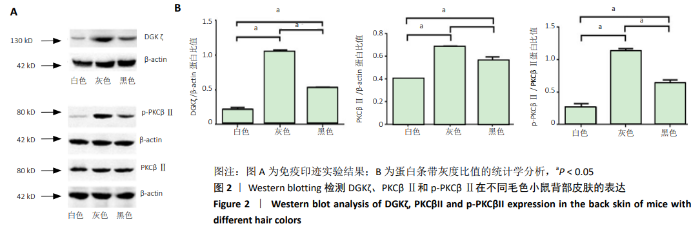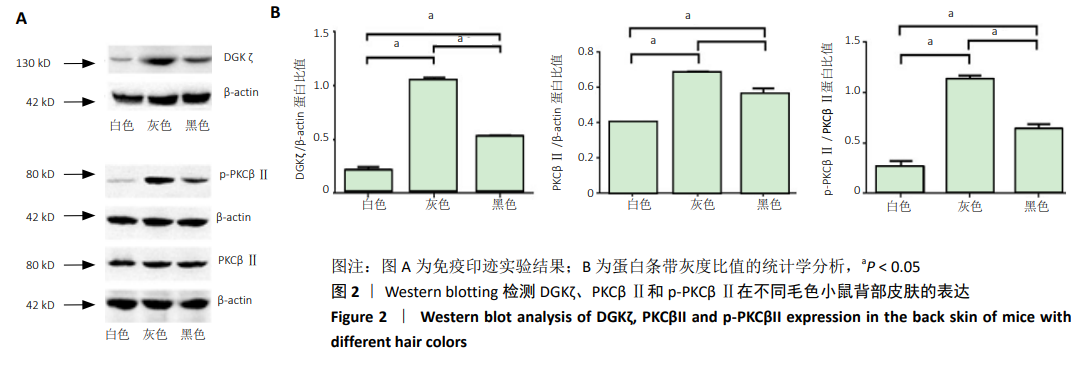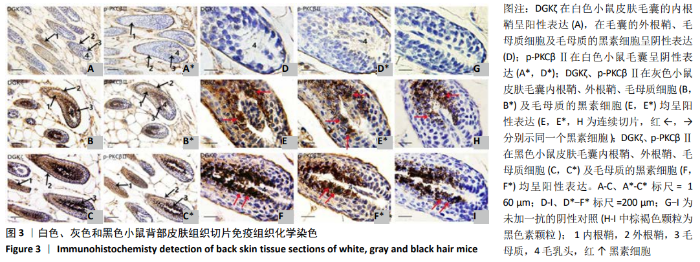[1] BALDANZI G. Inhibition of diacylglycerol kinases as a physiological way to promote diacylglycerol signaling. Adv Biol Regul.2014;55:39-49.
[2] KAWAGUCHI M, VALENCIA JC, NAMIKI T, et al. Diacylglycerol kinase regulates tyrosinase expression and function in human melanocytes. J Invest Dermatol.2012;132(12):2791-2799.
[3] KRASAGAKIS K, TSENTELIEROU E, CHLOUVERAKIS G, et al. Topography of Protein Kinase C βII in Benign and Malignant Melanocytic Lesions. Int J Surg Pathol.2017;25(6):497-501.
[4] PATERSON EK, FIELDER TJ, MACGREGOR GR, et al. Tyrosinase Depletion Prevents the Maturation of Melanosomes in the Mouse Hair Follicle. PLoS One.2015;10(11):e0143702.
[5] OLENCHOCK BA, GUO R, SILVERMAN MA, et al. Impaired degranulation but enhanced cytokine production after Fc epsilonRI stimulation of diacylglycerol kinase zeta-deficient mast cells. J Exp Med.2006; 203(6): 1471-1480.
[6] 李佳, 牛宝贝, 刘慧霞, 等. 甘油二酯激酶ζ、蛋白激酶Cδ和Tis21在发育中大鼠脑的表达和定位[J].解剖学报,2015, 46(5):609-615.
[7] BALDANZI G, BETTIO V, MALACARNE V, et al. Diacylglycerol Kinases: Shaping Diacylglycerol and Phosphatidic Acid Gradients to Control Cell Polarity. Front Cell Dev Biol.2016;4:140.
[8] Mérida I, Arranz-Nicolás J, Rodríguez-Rodríguez C, et al. Diacylglycerol kinase control of protein kinase C. Biochem J. 2019; 476(8):1205-1219.
[9] TOPHAM MK, BUNTING M, ZIMMERMAN GA, et al. Protein kinase C regulates the nuclear localization of diacylglycerol kinase-zeta. Nature. 1998;394(6694):697-700.
[10] KIKKAWA U. The story of PKC: A discovery marked by unexpected twists and turns. IUBMB Life. 2019;71(6):697-705.
[11] BROSE N, ROSENMUND C. Move over protein kinase C, you’ve got company: alternative cellular effectors of diacylglycerol and phorbol esters. J Cell Sci. 2002;115(Pt 23):4399-4411.
[12] ANN J, CZIKORA A, SAINI AS, et al. α-Arylidene Diacylglycerol-Lactones (DAG-Lactones) as Selective Ras Guanine-Releasing Protein 3 (RasGRP3) Ligands. J Med Chem.2018;61(14): 6261-6276.
[13] ENGLISH D.Phosphatidic acid: a lipid messenger involved in intracellular and extracellular signaling. Cell Signal.1996;8(5):341-347.
[14] BALDANZI G, BETTIO V, MALACARNE V, et al. Diacylglycerol Kinases: Shaping Diacylglycerol and Phosphatidic Acid Gradients to Control Cell Polarity. Front Cell Dev Biol.2016;4:140.
[15] FANG Y, VILELLA-BACH M, BACHMANN R,et al. Phosphatidic acid-mediated mitogenic activation of mTOR signaling. Science. 2001;294 (5548):1942-1945.
[16] YOON MS, ROSENBERGER CL, WU C, et al. Rapid mitogenic regulation of the mTORC1 inhibitor, DEPTOR, by phosphatidic acid. Mol Cell.2015; 58(3):549-556.
[17] BROWN JR, AUGER KR. Phylogenomics of phosphoinositide lipid kinases: perspectives on the evolution of second messenger signaling and drug discovery. BMC Evol Biol. 2011;11:4.
[18] SINGH BK, KAMBAYASHI T. The Immunomodulatory Functions of Diacylglycerol Kinase ζ. Front Cell Dev Biol.2016;4:96.
[19] ÁVILA-FLORES A, ARRANZ-NICOLÁS J, ANDRADA E, et al. Predominant contribution of DGKζ over DGKα in the control of PKC/PDK-1-regulated functions in T cells. Immunol Cell Biol.2017;95(6):549-563.
[20] LUO B, PRESCOTT SM, TOPHAM MK. Diacylglycerol kinase zeta regulates phosphatidylinositol 4-phosphate 5-kinase Ialpha by a novel mechanism. Cell Signal. 2004;16(8): 891-897.
[21] PARK HY, PEREZ JM, LAURSEN R, et al. Protein kinase C-beta activates tyrosinase by phosphorylating serine residues in its cytoplasmic domain. J Biol Chem. 1999;274(23):16470-16478.
[22] TOBIN DJ, BYSTRYN JC. Different populations of melanocytes are present in hair follicles and epidermis. Pigment Cell Res. 1996;9(6): 304-310.
[23] SLOMINSKI A, WORTSMAN J, PLONKA PM, et al. Hair follicle pigmentation. J Invest Dermatol. 2005;124(1): 13-21.
[24] FERNANDEZ-FLORES A, SAEB-LIMA M, CASSARINO DS. Histopathology of aging of the hair follicle. J Cutan Pathol. 2019;46(7):508-519.
[25] OH JW, KLOEPPER J, LANGAN EA, et al. A Guide to Studying Human Hair Follicle Cycling In Vivo. J Invest Dermatol. 2016; 136(1):34-44.
[26] ENDOU M, AOKI H, KOBAYASHI T, et al. Prevention of hair graying by factors that promote the growth and differentiation of melanocytes.J Dermatol. 2014;41(8):716-723.
[27] BUFFOLI B, RINALDI F, LABANCA M, et al. The human hair: from anatomy to physiology. Int J Dermatol. 2014;53(3):331-341.
[28] TOBIN DJ, PAUS R.Graying: gerontobiology of the hair follicle pigmentary unit. Exp Gerontol.2001;36(1):29-54. |





